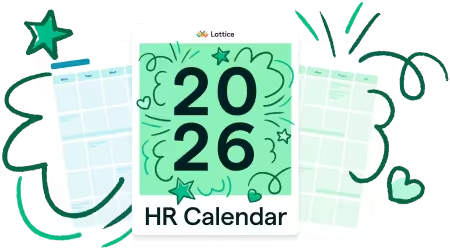Workplace Harassment Policy Template


Download this template for free
By submitting your information, you agree to Lattice's Terms of Service and Privacy Policy. You can opt out anytime.
Thanks! We'll be in touch soon.
Workplace harassment isn’t just a legal issue — it’s a cultural one. A proactive, clearly written workplace harassment policy helps build a respectful, inclusive environment where everyone can do their best work. It signals to employees that leadership takes their wellbeing seriously and has clear processes in place to protect them.
Workplace harassment can take many forms — from verbal abuse and unwanted conduct to more subtle forms of intimidation or bias-based behaviors. A policy that outlines unacceptable behaviors, establishes investigation protocols, and clearly communicates reporting options empowers your people team to act swiftly and fairly when concerns arise.
Whether you're creating a harassment policy from scratch or updating an existing one, this template provides the foundation for a document that meets both legal requirements and employee expectations.
What a Workplace Harassment Policy Should Include
A strong workplace harassment policy should be clear, comprehensive, and compliant with applicable laws. Here’s what to include:
- A clear definition of workplace harassment: Including sexual harassment, verbal abuse, bullying, psychological harassment, and discriminatory behavior.
- Examples of unacceptable behavior: This helps employees understand what qualifies as harassment — including both overt and subtle forms.
- Scope of the policy: Clarify that it applies to all employees, contractors, interns, vendors, and interactions at work-related events or digital communications.
- Reporting procedures: Outline how employees can report harassment (anonymously or not), to whom they should report, and what support is available.
- Investigation process: Explain how complaints will be handled — from intake to resolution — while maintaining confidentiality and fairness.
- Non-retaliation clause: State clearly that retaliation against individuals who report harassment will not be tolerated.
- Corrective action: Detail potential consequences for policy violations, up to and including termination.
- Training and communication: Describe how employees and managers will be trained on the policy.
- Policy review and updates: Include information about how often the policy will be reviewed and updated.
Purpose of a Workplace Harassment Policy
The primary purpose of a workplace harassment policy is to create a safe, respectful environment for all employees. But beyond that, it serves multiple goals:
- Protecting employees from harmful behavior that affects their wellbeing, productivity, and job satisfaction.
- Mitigating legal and reputational risk for the company by ensuring compliance with federal, state, and local harassment laws.
- Clarifying expectations so employees, managers, and leaders understand what constitutes harassment and how to respond.
- Building trust by offering a transparent and fair process for reporting and addressing complaints.
This policy is a key tool for reinforcing a culture of respect, inclusivity, and accountability — values that define strong, high-performing organizations.
Sample Workplace Harassment Policy
{{rich-highlight-1}}
1. Purpose
The purpose of this policy is to maintain a work environment that is free from all forms of harassment, including but not limited to sexual, verbal, psychological, and discriminatory harassment. We are committed to fostering a culture where employees feel safe, respected, and empowered to perform their best work.
2. Scope
This policy applies to all employees, including full-time, part-time, temporary, and contract workers, as well as interns, volunteers, vendors, and third parties who interact with our workforce. It covers conduct in the workplace, at off-site events (such as conferences and team outings), and during virtual communications including email, chat, and video calls.
3. Definitions
Harassment is defined as any unwelcome conduct — whether verbal, physical, visual, or digital — that is based on a protected characteristic, including race, gender, sexual orientation, religion, disability, age, national origin, or any other status protected by law.
Sexual harassment includes:
- Unwelcome sexual advances
- Requests for sexual favors
- Inappropriate or suggestive comments or jokes
- Display or distribution of sexually explicit materials
- Physical contact such as touching, hugging, or groping without consent
Other types of harassment may include:
- Use of slurs or derogatory comments
- Threats or intimidation
- Shouting, mocking, or belittling an employee
- Spreading rumors or exclusion from team activities
- Microaggressions that perpetuate bias or hostility
4. Examples of Unacceptable Behavior
Examples of behaviors that are not tolerated include, but are not limited to:
- Making offensive jokes or comments related to someone's identity
- Sharing memes, messages, or videos that are racist, sexist, homophobic, or otherwise inappropriate
- Commenting on someone’s appearance in a sexual or demeaning way
- Repeatedly asking someone out after they’ve declined
- Yelling at or publicly shaming a coworker
- Using performance reviews or assignments as a form of retaliation
5. Reporting Harassment
Employees who experience or witness harassment are encouraged to report the behavior as soon as possible. Reports can be made to:
- Your direct manager
- Any member of the People team
- Anonymously through [your internal hotline or reporting tool]
Reports will be treated with sensitivity, and confidentiality will be maintained to the greatest extent possible.
6. Investigation Process
All reports of harassment will be promptly reviewed and investigated. The investigation process may include:
- Interviewing the complainant, alleged harasser, and any witnesses
- Reviewing relevant documents or digital communications
- Keeping a detailed record of findings
At the conclusion of the investigation, the appropriate corrective action will be taken, which may include disciplinary measures up to and including termination.
{{rich-highlight-3}}
7. No Retaliation
Retaliation against individuals who report harassment in good faith, or who participate in an investigation, is strictly prohibited. This includes demotions, termination, reduction in hours, or any other adverse action.
If you believe you have been retaliated against, report the incident immediately using the same channels listed above.
8. Corrective Action
Corrective action for individuals who violate this policy may include:
- Verbal or written warnings
- Mandatory training
- Suspension
- Termination of employment
- Legal action, if necessary
The severity of the consequences will be determined by the nature and frequency of the violation.
9. Training and Awareness
All employees are required to complete annual harassment prevention training. Managers and leaders will receive additional training on how to identify, prevent, and respond to harassment in their teams.
The policy will be available in the employee handbook and shared with all new hires during onboarding.
10. Policy Review
This policy will be reviewed annually by the People team to ensure it remains compliant with applicable laws and reflects our evolving values and standards. Updates will be communicated promptly to all employees.
Frequently Asked Questions
What should I do if I witness harassment but am not directly involved?
If you witness harassment, you should still report it. Bystander intervention plays a key role in maintaining a respectful workplace. You can report it to your manager, the People team, or use the anonymous reporting tool.
Is joking considered harassment?
It depends on the context. Jokes that are offensive, targeted, or make others uncomfortable can be considered harassment — even if the intent wasn’t malicious. What matters is the impact on the recipient.
Can I be punished for making a false report?
Employees who intentionally make false reports may face disciplinary action. However, good faith reports — even if they don’t result in a finding of harassment — are protected from retaliation.
Does this policy apply to remote employees?
Yes. Harassment can occur over Zoom, email, chat, or any other digital communication tool. The same standards of respect apply, regardless of where you work.
How will I know if my report led to action?
While specific disciplinary actions are confidential, the People team will follow up to let you know that your concern was reviewed and that appropriate action has been taken.
What if I think the harassment is my fault?
No one deserves to be treated unkindly at work in any circumstance. If you feel you have experience any of the harassment behaviors listed above (or if you're unsure if what you experienced meets the definition of harassment), reach out. The People team is here to support you and make work a comfortable and safe space for you.
{{rich-highlight-2}}
🚩 Please note: This sample policy is for informational purposes only and does not constitute legal advice. It is a generic template that may not suit your specific circumstances. When adopting or revising a policy, consult legal counsel to ensure compliance with all applicable laws and regulations.
✨ Disclaimer: This resource was developed with the help of artificial intelligence, though reviewed, edited, and approved by (real) humans.
Frequently Asked Questions

Your people are your business
Ensure both are successful with Lattice.





.webp)